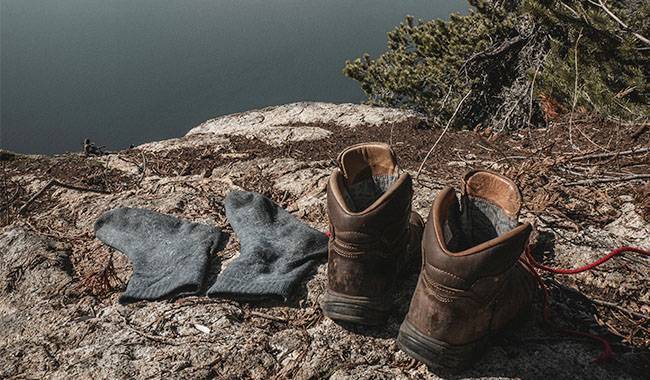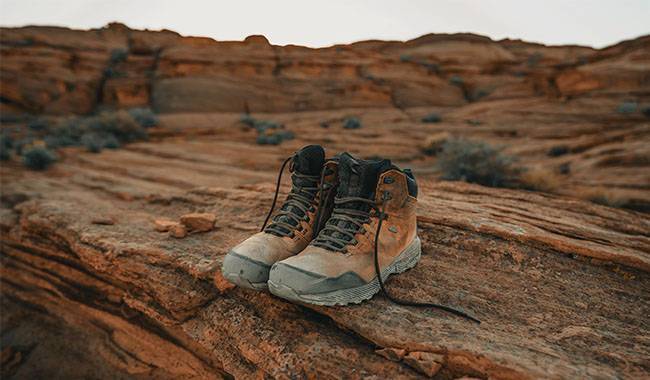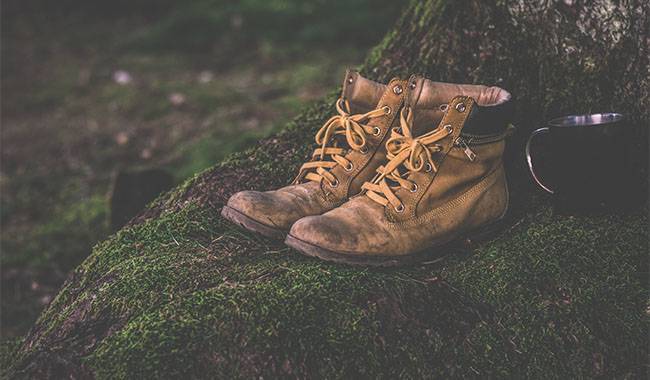
First of all, it’s normal to have wet feet when camping. It’s not uncommon to step in puddles, stumble across a creek, cross a river at a fork in the road, or fall into a knee-deep swamp. You don’t have to be afraid of it, but you do have to be prepared. In this LCN Outdoors article, we’ll look at a few ways to dry your boots while camping and hiking.
The first thing we’re going to do is clean the dirt from the shoes and remove the excess water with an absorbent method. You can use a sock as an absorbent. Stand in the shoes, the socks absorb the moisture, take them off, wring them out, and put them back in the shoes. Socks can be dried regularly on a burner (remember safety precautions for using an open fire in a tent).
A special microfiber towel is more effective than socks. It is compact, lightweight, and can absorb moisture in seconds. A towel will always come in handy when camping, and it dries faster than your socks.
A classic kitchen paper towel absorbs moisture well. For best results, you can use toilet paper. Just don’t forget to calculate the amount for each class. If you’re in the woods, you can dry your hiking boots with dry moss. It absorbs moisture like a sponge.
Shoe drying does not include insoles and laces, and this rule applies to all drying methods. Insoles retain moisture and prolong drying time, so they are easier to dry when removed from the shoe. Laces, on the other hand, just get in the way of drying, and they tend to fall into the fire and prevent the neck of the boot from opening fully. Here are ten ways to dry hiking boots, and you can choose one or a combination of them.
How To Dry Hiking Boots By The Fire
Let’s start with the first and most logical method that comes to mind for people who wear wet shoes. Not only is this method the most popular, but it is also the most dangerous: how many tourists leave without their shoes!”.
Let’s face it, we’re against this option, no matter how carefully you do it. Not all hiking boots can be dried over a fire. Most modern materials are simply not heat resistant. Membrane shoes may lose their properties altogether, and it is recommended that they be dried in a place away from heat sources.
What happens to hike boots when drying them by fire.
- Your shoes may “shrink” and you won’t be able to put them on your feet at all.
- Boots can get burned by sparks, which can easily leave holes in the synthetic fabric.
- If you are inattentive for a long time while talking to your companions, the shoes will burn completely.
If you decide to put the method of drying hiking boots by the campfire into practice, there are a few rules to keep in mind.
- Boots by the campfire are dried by hand, not placed next to or snuggled up against pebbles or logs. Be aware that one careless move, a gust of wind, or a more intense fire can leave you without shoes.
- Keep your boots as far away from the fire as possible, as you can hold them in your hands without burning yourself.
- Holding the neck of your boots up to a heat source, i.e. a campfire, is the most effective way to dry them.
If you follow these rules, the risk of losing your shoes will be reduced. However, you should think twice before using this method to dry your hiking boots, because walking in wet shoes is much better than walking without shoes at all.

Sun-drying or air-drying
This is one of the safest ways to dry your shoes. If nature decides to bring you good weather after a wet crossing, all you have to do is untie your boots and put them in the sun and the sun will do all the work for you. That way, you don’t have to keep an eye on your boots and you can just mind your own business. In addition, the sun will do little to no damage to your shoes. The only thing you need to worry about is changing the location of the shade during the day – with recent exposure to the sun, your shoes may end up in the shade, and then the chances of them drying out are significantly reduced.
It’s worth remembering that if you’re hiking in an area prone to all sorts of poisonous creepy crawlies, it’s worth checking your shoes after you’ve dried them for all sorts of things, such as scorpions and spiders, that are attracted to the shade of the neck of your boots.
Wipe your boots yourself
This drying method is also effective and safe. Just pour out the standing water in the shoes, squeeze out the insoles, squeeze out the socks, and put the shoes back on. The body, warmed by physical exertion, becomes a great “battery” and dries out the wet shoes over time.
This is the method used by the author of this article while camping in the summer. Of course, it is best not to use this method at low temperatures to avoid frostbite on the extremities.
How to dry your hiking boots with a stone
For this method, we need small rocks, put them in a kettle or an old jar, and place them on fire or burner. When the stones are sufficiently heated, but not yet white-hot, we pour them into the shoes. If you are afraid of getting your shoes dirty from the inside, you can wrap the stones in a handkerchief. The shoe with the stones in it should be shaken constantly and sufficiently so that the stones keep tumbling. It is important not to leave the stones in one place for too long, or they will destroy the shoe. When the stones have cooled down, you can repeat this procedure a few times until the boots are dry. This method is so effective that even very wet boots can be dried out in a few minutes. Note, however, that for shoes with thin synthetic linings and membranes, this method is not suitable – the stones will simply melt the fragile synthetic material.
Shine Shoes With Sand While Hiking
This method requires sand. Pour it into a large pot or any other container and place it over the fire. The heated sand is then poured into a worn-out sock. The sock filled with hot sand goes inside the boot. Such a sand warmer dries the boots perfectly because it occupies the maximum area of the sock. This operation should be repeated several times to achieve the best results.
Drying With A Hot Water Heater
For this method, we need two 0.13 gals (0.5 liters) bottles. If you take turns drying your boots, one bottle will be enough. Pour boiling water into the bottle and place the bottle in the shoe. This method is quite time-consuming because the water cools quite quickly and the heating pad has to be filled more than once to dry the boots.
How To Dry Your Boots In A Sleeping Bag
This method is for the toughest hikers and climbers – wet boots are placed directly in the sleeping bag and then dried by the heat of the body. This is more of an extreme drying method because you can forget about sleeping comfortably in your sleeping bag with wet boots.
The Classic Shine Shoes With Newspaper
Drying with a newspaper is a well-known and common method that dates back to our grandmother’s time. Some hikers still carry newspapers on their hikes to dry their shoes. Newspapers are really good at absorbing moisture and can dry wet boots – you just need to put enough newspaper in your shoes. The downside to this method is obvious: the extra weight of the newspaper in your pack. Obviously, it’s not very rational to bring newspapers on a long hike. In some cases, newspapers can be replaced with some of the dry and absorbent natural materials that can be found on a hike, such as dried leaves, moss, or grass.

Autonomous Heat Source Teploid And Phase-change Material To Dry Your Boots
Autonomous heat source Teploid and Phase-change material are usually used to keep cold hands warm, but they are also great for drying shoes. There are even special models of warmers in the shape of insoles. Autonomous heat source Teploid is usually small bags that contain a compound. This chemical reacts with oxygen to produce heat. The disadvantage is that the heat is disposable, so it is not very practical.
The phase-change material is usually a silicon reservoir filled with a supersaturated salt solution with a small metallic element floating inside. It is this element that “triggers” the heating pad – by slightly bending this metal part, the salt solution comes out of rest and starts a crystallization process. In this process, heat is also released. After the Phase-change material has been used and cooled, you can place it in boiling water for about 10 minutes and it will return to its original liquid state, ready to be used again. This Phase-change material is a reusable item, so this device element has a big advantage over the enthusiast. But equally, it adds extra weight to your backpack.
Dry Your Hiking Boots With Desiccant Silica Gel
This method is not often used in tourism but should be included to complete the picture. In this case, use Desiccant Silica Gel to remove the moisture from the shoe. You may know that this substance comes in the form of a small paper bag with a transparent ball that is placed in the box containing the new shoes. In this case, the purpose of Desiccant Silica Gel is to absorb excess moisture and prevent the shoes from drying out. A common message written on these bags was, “Throw away. Don’t eat,” but campers often ignore the first of these two rules and use these bags for camping. Of course, there is no need to try to accumulate the right amount of Desiccant Silica Gel by buying up shoes. Desiccant Silica Gel can be bought in any quantity online or at shoe stores. Our experiments with Desiccant Silica Gel to soak up shoes show that this method works better for We have experimented with Desiccant Silica Gel to show that this method works better on slightly damp shoes, but really damp shoes are very difficult to dry with Desiccant Silica Gel. It also takes a long time to dry, and the presence of Desiccant Silica Gel in the backpack adds weight to the pack.
What The Manufacturer Says About Drying Shoes
Let’s take a look at the shoe manufacturers’ recommendations for the best way to dry boots while camping and at home. Most manufacturers state in their care instructions that even direct sunlight can damage footwear, let alone dry over a fire or with heated stones. They recommend drying your shoes in the wind. Some manufacturers do not recommend speeding up the drying process. Every hiker balances the desire to wear dry shoes with the desire to keep them dry for as long as possible, and depending on their priorities, they will choose the drying method that works best for them.
Tip: Buy quality hiking shoes that are suitable for your hiking conditions and don’t neglect to lace them up. In cold and wet conditions, the quality of your gear can make or break not only your enjoyment of the hike itself but also your health and even your life.